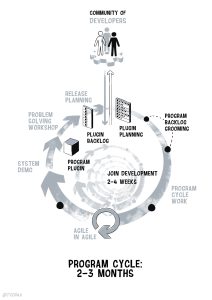
BPMN notation and requirements management here is perhaps the only high-quality tool that allows you to coordinate the activities of complex mechanisms and technical processes (digital communications, wireless networks, digital content provision, SMS services, etc.). This management model is usually used to synchronize very time-accurate and highly complex workflows, including those that require simultaneous and continuous use in several business units.
Thanks to this methodology, it is possible to facilitate the construction and continuous improvement of information systems at the initial stage of project development processes. This approach improves operational visualization, and captures gaps in knowledge of the areas involved, thereby helping to accumulate and track feedback, and improve the quality of services provided, thus helping to reduce risks and increase customer satisfaction. In the case of airlines, train stations, telecom operators, internet service providers, etc. The level of customer satisfaction with their services directly affects the profitability of these institutions.
In addition, by documenting both manual and automated processes, it becomes possible to identify potential areas for improvement, optimize the entire system, and avoid receiving negative feedback in the future.
BPMN at a Glance
In contrast to traditional methods of identifying requirements and according to the authors of the study “An Approach of Software Requirements Elicitation Based on the Model and Notation Business Process (BPMN)”, the proposed approach using BPMN is optimal for managing them, due to the following:
Like any system, BPMN notation has its advantages and disadvantages. To the above advantages, we can add that this method:
- enables the BA specialist, PM, and business to consider strategic needs holistically, facilitating the identification of requirements and their priority.
- allows you to reduce the workload associated with automated requirements’ volume, understanding, and instability.
The main disadvantages include the fact that the use of BPMN notation:
- It requires considerable effort to understand and distinguish between what a business flow is and what a system flow is.
- Tracing targets can be vulnerable, forcing the creation of an additional artifact in the claims document.
However, all these shortcomings and their possible consequences are easy to prevent if you contact an experienced developer or development team. Therefore, it can be stated that the disadvantages of using BPMN are purely conditional.
Advantages
The main benefits of managing and analyzing software requirements using BPMN notation include: reducing the risk of project failure, improving communication between participating parties and developers in particular, identifying potential problems early in the development process, and creating a clear and complete set of requirements that can and will be used to manage software development.
The problem with agile methodologies in large enterprises is that one integration error can easily lead to many others. How businesses integrate methodology can go unsettled, and a process that should create an advantage for companies becomes a bug to their success.
A thorough and effective analysis of requirements, including taking into account the flexible approach, allows the team to improve communication and interaction between all members, coordinate the software product as accurately as possible following the terms of reference of the business, to increase user satisfaction and to improve the quality of the finished software product.
BPMN notation offers system solutions for the modernization and qualitative digital transformation of any business, especially when it comes to one of the most dynamic industries – communications and telecom, where timely technological progress is often equal to competitive advantage in the market, both in time and in resources. In turn, BPMN Low Code is a compact and effective solution for tasks with deadlines and release limitations, or when various development teams are combined in one project for short periods and it is not possible to write code from scratch, etc.
In the example of project implementation in the MEF platform. DEV, when creating applications using BPMN Low Code, the program cycle of projects is as follows:

In other words, using BPMN notation during management and analysis of software requirements provides opportunities for collaboration between the Customer’s development teams and the supplier, namely, they develop together – at the low-code level, the customer creates omnichannel management and business logic, the supplier implements backend and maintenance, ensuring reliable execution of your IT operations. Business analysts, programmers, and architects work for results thanks to business-oriented design. Automation at the BPMN level Low Code provides code generation, testing capabilities, and DevOps – the customer tracks progress, measures bottlenecks, and manages changes. The seamless deployment includes automatic documentation, versioning, accounts, and configuration.
The RACI Matrix
The proposed matrix of efficiency of the RACI project (R – Responsible, A – Accountable, C – Consult, I – Inform):
| Activity | Customer’s team | MEF. DEV Team |
| Defines goals and scope of changes | R | I |
| Explores current business processes, IT systems, and environments to identify a potential transformation plan that meets business goals. | A | R |
| Forms requirements set functionality and characteristics, | R | C |
| Compares them with security requirements, rules and technologies in the field of software development | A | R |
| Creates a schedule of the project, according to the required timing and available budget. | R | C |
| Carries out part of the development of business logistics and orchestration omnichannel at the level of BPMN Low Code | R | C |
| Carries out part of the development and backend support, ensuring reliable execution of your IT operations | A | R |
| Independently make changes and develop projects | R | C |
| Provides training and individual support so that new solutions work, develop, and can solve the following tasks. | A | R |


